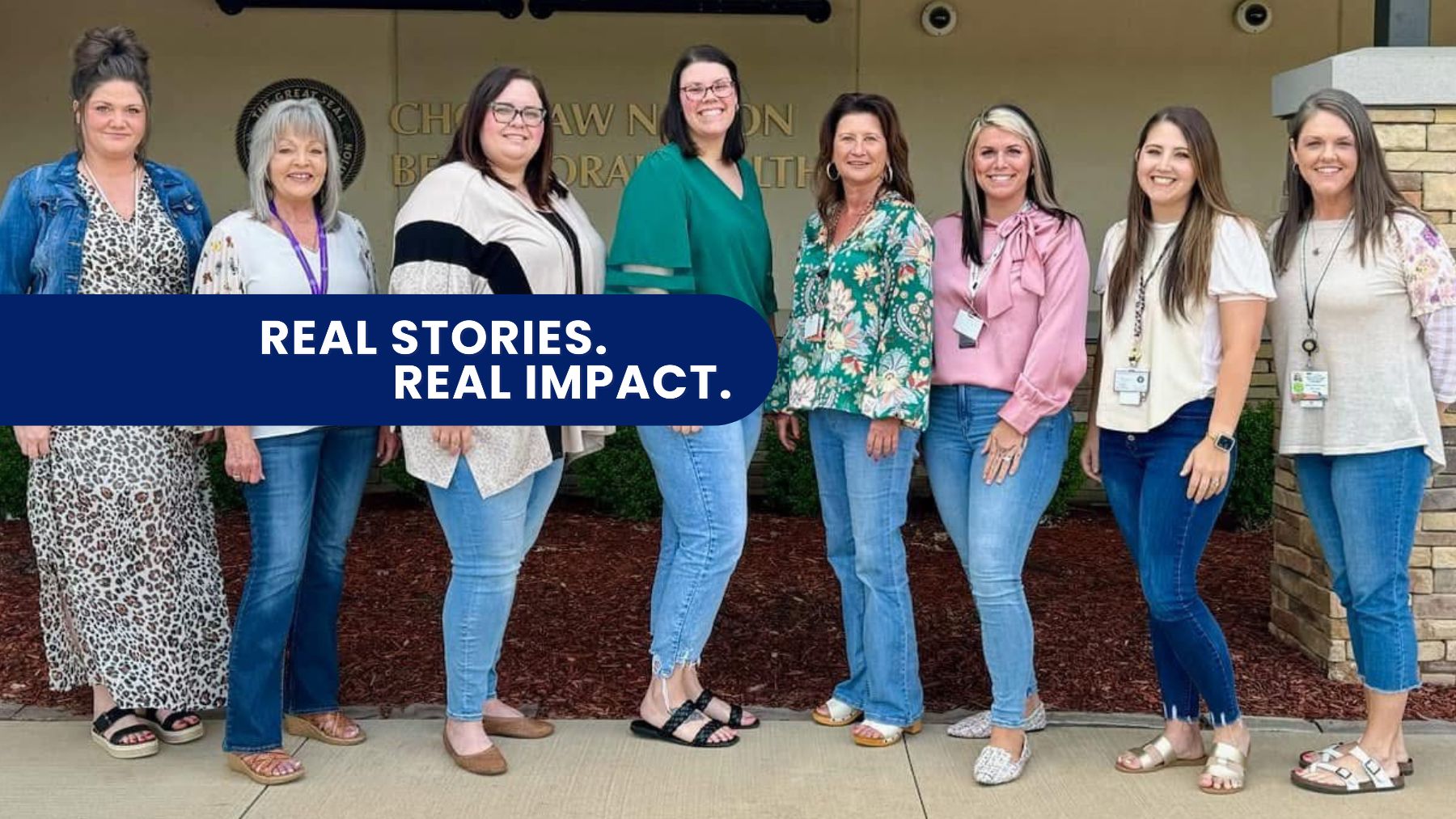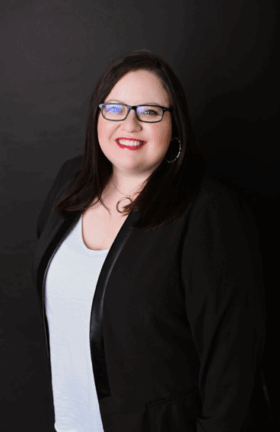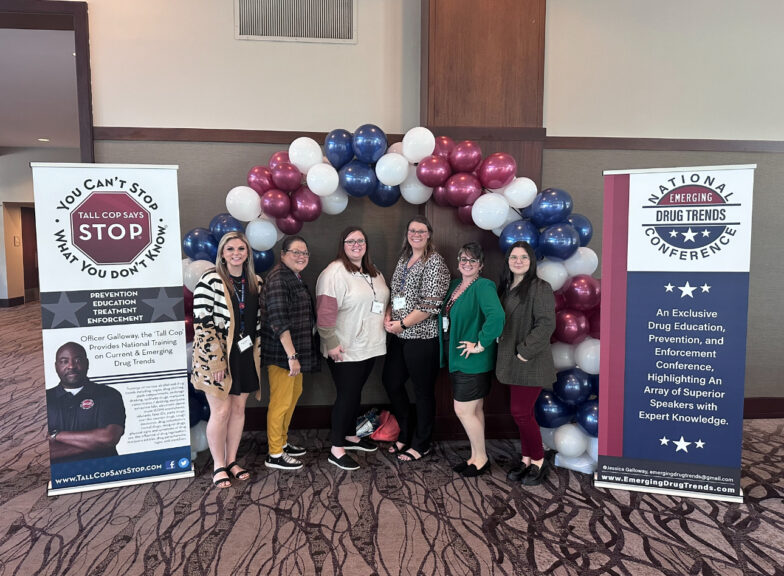
For Lacey Callahan, LMSW, Grants Operations Manager at Choctaw Nation Behavioral Health (CNBH) in southeastern Oklahoma, addressing tribal substance use disorders (SUD) is more than a professional mission—it’s deeply personal. Growing up in a rural community on the Choctaw Nation reservation, Canadian Shores, has shaped her understanding of both the challenges and strengths of the communities she serves.
“There were no stop lights in the town I grew up in,” Lacey said. “There was one church, a bar, and a Volunteer Fire Department.”
Growing up in an extremely rural environment, Lacey faced challenges that went far beyond isolation. Substance use was a constant presence in her community. “The house next door to me exploded due to being used as a meth lab,” she said. “Aluminum foil and used needles covered the streets.” Lacey’s mom was a nurse who helped steer her away from substance use and other negative influences, but many of her classmates weren’t as lucky. Her graduating class was only 26 people, many of whom are either incarcerated or deceased.

Lacey has spent over six years with Choctaw Nation Behavioral Health, bringing her experience and professional expertise to combat SUD within tribal communities. Prior to joining CNBH, she worked as a District Director for Child Welfare Services with the state of Oklahoma.
Cultural Understanding as a Foundation
Lacey’s deep roots in the area help her understand the diversity within Native American communities. “Choctaw Nation is adjacent to Cherokee Muskogee Creek, and Chickasaw Nation—there are cultures within the cultures,” she said. While acknowledging differences, she noted that the tribes share common threads of “being a resilient people, having a lot of strength, leaning on each other for support, and being very resourceful.”
This cultural framework shapes how tribal substance use issues show up and offers clues about how to help address them. Lacey noted that tribal individuals “have a tendency to be more reserved and not as outwardly vocal. They really try to lean on one another for support.”
Families tend to keep problems to themselves, sometimes delaying intervention until situations have escalated to crisis levels. “If they’re not outwardly speaking about their internal struggles, then sometimes it can become a lot to handle. And so at those times, I feel like that’s when we could see them more—when it’s exacerbated to this point of, ‘Oh my goodness, something needs to be done.’”
Challenges in Rural Tribal Substance Use Prevention
Working in rural tribal communities presents unique challenges, Lacey acknowledges. Some schools hesitate to have open discussions about “taboo subjects,” which makes it harder to educate youth about substance use. Resource gaps, particularly during summer months when school is out, means less oversight from adults outside the home.
While working for the state in child welfare, Lacey saw a familiar ebb and flow in referrals. “When school lets out, our referrals would decline immensely,” she said. “When school would start back in August, our referrals for child abuse and neglect would grow exponentially because there are now other adults seeing what’s going on in the home.”
Intergenerational trauma also plays a significant role in tribal substance use patterns. “People seek security and comfort and what feels good to them, whether it is healthy or not healthy,” Lacey said. If adults in their lives used substances for comfort, it’s seemingly more likely their children will, and it carries through the generations. This makes it especially difficult for individuals to try to break cycles of substance use to maintain family bonds.
Adapting Strategies to Meet Community Needs
Flexibility and community input drive Lacey’s approach to tribal substance use intervention in Choctaw Nation. When Narcan distribution community meetings weren’t getting the hoped-for participation, her team pivoted. First, they tried drive-up Narcan distribution to help preserve individuals’ privacy, while still providing them the life-saving medicine. Still, they found they weren’t reaching everyone. “We received a phone call from a housing manager who said, ‘There are many who do not have transportation, but they still struggle with this, so they can’t get to you. Can you come and set up in the middle of the housing area and just let them walk up?’” So that’s what they did.
Being open to adaptation extends to other initiatives, from drug take-back days with door prizes to detention center support groups. Lacey said feedback from the community drives much of what they do. “The community members are the experts on what’s going on,” she said.
The Power of Connection in Recovery
Among the promising developments in Lacey’s work is the implementation of the Connections smartphone app, part of CHESS Health’s eRecovery digital solution, which provides 24/7 peer support and crisis response for those in recovery from SUD. All residents of Choctaw Nation and the nearly 30 other tribes represented there have access to Connections.
“It just takes one person to care about you—one healthy individual to care about you,” Lacey said, explaining why she believes in the app’s potential. “The Connections app does that—you have people who are seeking healthy traits together and leaning on each other. They connect on a greater level. If you have that, and you have that structure, they’re not going anywhere. They are going to care about you regardless. It gives you the most hope.”
The app has gained a positive reception in the tribal community. Lacey shared that she recently met with a tribal councilman who was “super encouraged about Connections” and wanted to “spread it widely to optimize utilization.”
Looking Forward with Optimism

Despite the many challenges facing Choctaw Nation, Lacey remains hopeful about the future of SUD treatment for several reasons.
First, the dedication of the team inspires her. “We have individuals who have a lot of heart and the ability to connect greatly,” she said. “They let people know they are seen, maybe for the first time in their lives.”
She’s also excited about newer prevention initiatives, such as a mock bedroom setup that helps parents see where their children might conceal drugs and a mobile meth lab that helps members of the community learn what meth smells like and what to be aware of. They’re also teaching families about ways youth might use social media to obtain drugs. These efforts help parents and families with tools to look out for red flags before young people get swept up in drug use.
And finally, she is seeing improved access to care: “The support list for services has decreased immensely,” she said. “People are obtaining vital services more quickly.”
For Lacey, meaningful change comes from connection. Whether through innovative technology like the Connections app or through dedicated professionals who understand the communities they serve, building relationships has the potential to change the trajectory of the crisis of SUD in Choctaw Nation.
